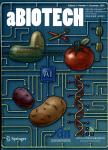Genome editing toward biofortified soybean with minimal trade-off between low phytic acid and yield
作者机构:Sanya Institute of China Agricultural UniversitySanya 572000China College of AgronomyChina Agricultural UniversityBeijing 100193China Guangdong Provincial Key Laboratory of Plant Adaptation and Molecular DesignInnovative Center of Molecular Genetics and EvolutionSchool of Life SciencesGuangzhou UniversityGuangzhou 510006China College of Life SciencesFujian Agriculture and Forestry UniversityFuzhou 350002China
出 版 物:《aBIOTECH》 (生物技术通报(英文版))
年 卷 期:2024年第5卷第2期
页 面:196-201页
核心收录:
基 金:supported by the Guangzhou Science Grant(2024A03J0010)to YG
主 题:Genome editing Phytic acid Soybean Agronomic traits CRISPR/Cas9
摘 要:Phytic acid(PA)in grain seeds reduces the bioavailability of nutrient elements in monogastric animals,and an important objective for crop seed biofortification is to decrease the seed PA ***,we employed CRISPR/Cas9 to generate a PA mutant population targeting PA biosynthesis and transport genes,including two multi-drug-resistant protein 5(MRP5)and three inositol pentose-phosphate kinases(IPK1).We characterized a variety of lines containing mutations on multiple IPK and MRP5 *** seed PA was more significantly decreased in higher-order mutant lines with multiplex ***,such mutants also exhibited poor agronomic *** the population,we identified two lines carrying single mutations in ipk1b and ipk1c,*** mutants exhibited moderately reduced PA content,and regular agronomic performance compared to the wild *** study indicates that moderately decreasing PA by targeting single GmIPK1 genes,rather than multiplex mutagenesis toward ultra-low PA,is an optimal strategy for low-PA soybean with a minimal trade-off in yield performance.




